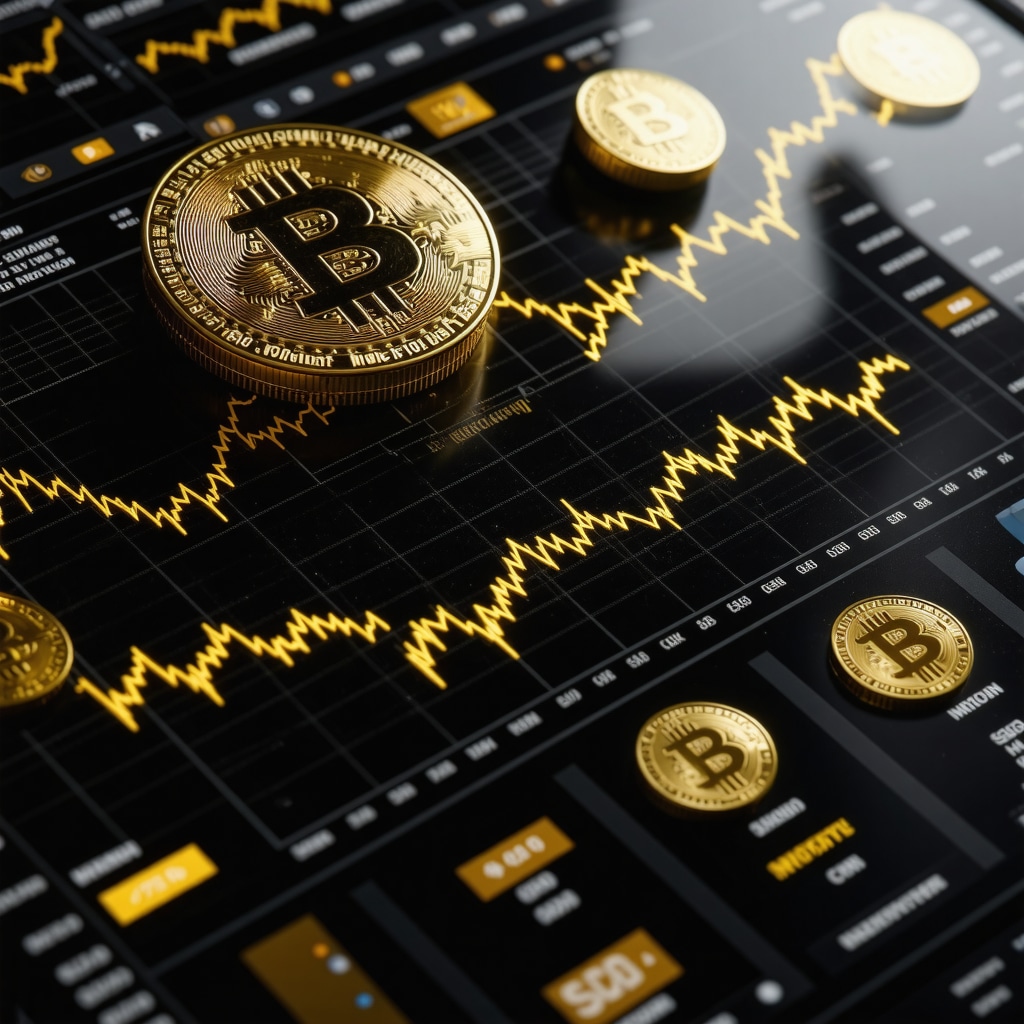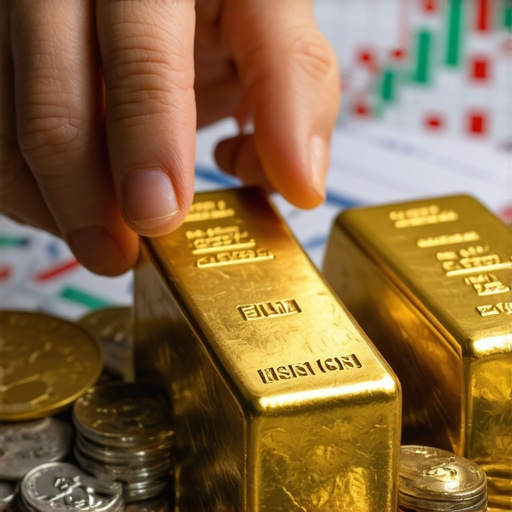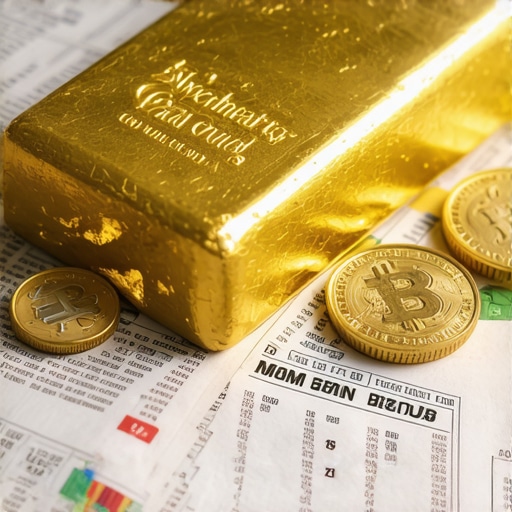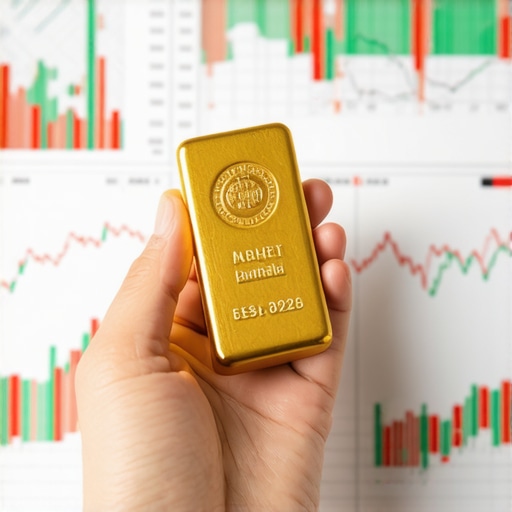Unlocking the Golden Door: Why New Investors Should Consider Gold
For centuries, gold has been a symbol of wealth, a hedge against inflation, and a safe haven during economic uncertainty. If you’re new to investing, the allure of gold may seem straightforward—shiny, valuable, and timeless. However, diving into gold investment without a clear strategy can be daunting. Understanding the nuances behind gold’s market behavior and investment vehicles is crucial for any beginner aiming to start smart and build a resilient portfolio.
Beyond the Shine: Exploring Diverse Gold Investment Options
Gold investment isn’t limited to buying physical bars or coins. For beginners, diversification within gold-related assets can enhance both security and growth potential. Consider options like gold mining stocks that offer exposure to the industry’s upside with the liquidity of equities. Alternatively, gold ETFs provide a convenient and cost-effective way to participate in gold price movements without the hassles of physical storage. This layered approach, balancing tangible assets with financial instruments, exemplifies prudent investment planning.
The Art of Timing: How to Identify the Right Entry Point
Market timing is an art and science, especially in gold investing. Unlike volatile stocks, gold often reacts to macroeconomic trends such as inflation rates, currency fluctuations, and central bank policies. New investors should monitor indicators like the U.S. Dollar Index or central bank gold purchases, which historically impact gold prices significantly. For instance, when inflation expectations rise, gold typically appreciates as investors seek to preserve purchasing power. Learning to interpret these signals can transform your gold investment from guesswork to informed decision-making. For deeper insights, explore how central bank gold purchases affect global gold prices.
What Are the Common Pitfalls Beginners Should Avoid When Investing in Gold?
One frequent mistake is neglecting the costs associated with physical gold, such as premiums, storage fees, and insurance, which can erode returns. Additionally, some beginners buy gold at market peaks driven by hype, only to face price corrections. Another trap is concentrating investments solely in one form of gold, missing out on diversification benefits that reduce risk. Educating yourself on these aspects—perhaps starting with a guide like investing in gold for beginners: avoid common mistakes—can preserve capital and optimize long-term gains.
Practical Wisdom: Securing Your Physical Gold Safely
Physical gold ownership introduces unique considerations. Beyond acquisition, safeguarding your investment against theft, loss, or damage is paramount. Professional vault storage and insurance policies tailored for precious metals offer peace of mind. For those interested in the logistics of safe custody, resources like physical gold storage solutions provide detailed strategies. Remember, the security of your asset is as critical as the purchase itself.
Empowering Your Journey: Where to Learn More and Join the Conversation
Gold investing is a dynamic field blending history, economics, and finance. Engaging with expert communities and continuously updating your knowledge will sharpen your investment acumen. Feel free to share your experiences or questions below—your insights might illuminate another beginner’s path. For comprehensive beginner guidance, check out investing in gold for beginners: how to start confidently.
Authoritative source: The World Gold Council provides extensive research and market analysis essential for informed gold investing decisions. Visit their official site at gold.org for current data and insights.
Reflections on Diversifying Within Gold: My Personal Approach
When I first started investing in gold, I was tempted to go all-in on physical gold bars, enchanted by their tangible value and timeless appeal. However, over time, I realized this singular focus limited my potential to benefit from the broader gold market dynamics. Diversifying across gold mining stocks and well-managed ETFs has since become a cornerstone of my strategy. For example, holding shares in select gold mining stocks has given me exposure to operational leverage—when gold prices rise, mining profits often increase at a faster rate.
At the same time, gold ETFs provide a flexible, cost-effective way to participate in gold’s price movements without the burdens of storage or insurance. This mix has helped me balance risk and liquidity while still capturing upside potential. If you’re considering a similar approach, take time to analyze individual mining companies’ fundamentals as well as ETF expense ratios and tracking accuracy.
Understanding the Influence of Global Events on Gold Prices
One realization from following gold markets closely is how sensitive gold prices are to geopolitical and economic events. For instance, shifts in central bank policies or unexpected inflation reports often trigger swift gold price movements. The World Gold Council’s insights, which I frequently consult at gold.org, have been invaluable in understanding these complex relationships.
Recently, as central banks around the world increased their gold reserves, this demand contributed to tightening supply and upward price pressure. Monitoring these activities alongside macroeconomic indicators like inflation expectations and currency strength has enhanced my ability to anticipate favorable entry points.
How Can Beginners Stay Grounded Amid Gold Market Volatility?
Gold’s reputation as a safe haven can sometimes lull investors into complacency, but market swings are inevitable. I often ask myself: How can I maintain a steady course during periods of volatility? From experience, setting clear investment goals and adhering to a disciplined plan helps avoid emotional decision-making. Regularly reviewing your portfolio and rebalancing as needed ensures you don’t overexpose yourself to one asset class.
Additionally, educating yourself on different gold investment vehicles and their risk profiles—whether it’s physical gold, ETFs, or mining stocks—empowers you to make choices aligned with your tolerance and timeline. For practical tips, resources like gold investment strategies balancing risk and reward offer actionable guidance.
The Practicalities of Managing Physical Gold: Storage and Security
After deciding to include physical gold in my portfolio, storage quickly became a top concern. I learned that home safes, while convenient, don’t offer the same level of security as professional vaults equipped with advanced protection and insurance. Opting for a reputed physical gold storage solution gave me peace of mind, knowing my investment was shielded against theft or damage.
Also, keeping documentation and proof of ownership up to date is crucial for resale or insurance claims, a lesson I learned the hard way when first buying from less reputable dealers. Always verify dealers’ credentials and seek transparent pricing to avoid pitfalls.
Have you had experiences managing physical gold storage or navigating related challenges? I’d love to hear your stories or questions in the comments below. Sharing our journeys helps build a community of informed and confident gold investors.
Decoding the Complex Dance: How Geopolitical Shifts and Monetary Policies Shape Gold’s Trajectory
The intricate interplay between global geopolitical events and monetary policies is a key driver behind gold’s price fluctuations. Central banks’ decisions to alter interest rates or adjust their gold reserves ripple through markets, influencing investor sentiment and liquidity flows. For example, when the Federal Reserve signals a dovish stance amidst economic uncertainty, gold often rallies as a preferred store of value. Conversely, hawkish policies with rising interest rates can temper gold’s appeal due to higher opportunity costs of holding non-yielding assets.
Geopolitical crises—ranging from trade tensions to armed conflicts—inject volatility and risk aversion into financial markets, often propelling gold to new highs as a safe haven. The 2020 global health crisis exemplified this phenomenon, where unprecedented stimulus measures and uncertainty lifted gold prices dramatically. Understanding these macro drivers requires continuous monitoring and sophisticated analysis, often leveraging resources like the World Gold Council’s Gold Hub Research, which provides granular data and expert commentary on these evolving dynamics.
What Advanced Analytical Tools Can Investors Use to Forecast Gold Price Movements?
Beyond fundamental analysis, seasoned investors employ quantitative models integrating macroeconomic indicators, technical chart patterns, and sentiment analysis to forecast gold price trends. Tools like econometric models assess variables such as inflation expectations, real interest rates, and currency strength to predict gold’s trajectory with greater precision. Additionally, machine learning algorithms trained on historical price data and global event markers have emerged as cutting-edge methods to detect subtle market signals.
Technical analysts scrutinize moving averages, Relative Strength Index (RSI), and Fibonacci retracements to identify potential entry and exit points. Sentiment indicators, derived from futures market positioning and investor surveys, help gauge market consensus and contrarian opportunities. Combining these approaches enhances decision-making beyond simple trend-following, enabling investors to anticipate turning points and mitigate risks effectively.
Integrating Gold into a Broader Portfolio: Sophisticated Approaches to Risk Management and Performance Optimization
While gold is traditionally viewed as a hedge against inflation and currency depreciation, its role within a diversified portfolio is multifaceted. Advanced portfolio managers consider gold’s low correlation with equities and bonds as a strategic advantage, especially during market downturns. However, allocation size and entry timing must align with an investor’s risk tolerance, investment horizon, and overall financial objectives.
Dynamic asset allocation strategies periodically rebalance gold exposure based on macroeconomic forecasts and market valuations. For instance, tactical increases in gold holdings may be warranted during early inflationary cycles or geopolitical turmoil, whereas a more conservative stance might prevail during stable growth periods. Furthermore, leveraging gold derivatives—such as options and futures—can provide sophisticated hedging mechanisms and enhance returns through strategic positioning.
Understanding tax implications and liquidity constraints associated with different gold investment vehicles is also vital for optimizing after-tax returns and maintaining portfolio flexibility. Engaging with financial advisors specialized in commodities can unearth personalized strategies that harmonize gold investment with broader wealth management goals.
Harnessing Technology for Seamless Gold Investment: Digital Platforms and Blockchain Innovations
Emerging technologies have revolutionized gold investing, making it more accessible, transparent, and secure. Digital gold platforms now enable investors to purchase fractional gold holdings with instant settlement and minimal fees, democratizing access beyond traditional physical and ETF formats. These platforms often integrate robust security measures and regulatory oversight, fostering trust among users.
Blockchain technology is pioneering new frontiers by tokenizing gold assets, ensuring provenance and immutable ownership records. This innovation addresses longstanding challenges related to authenticity, counterparty risk, and liquidity. For example, tokenized gold can be traded 24/7 on decentralized exchanges, expanding market accessibility and efficiency.
While these advancements present exciting opportunities, investors should conduct thorough due diligence, evaluating platform credibility, regulatory compliance, and custodial arrangements. Staying abreast of technological trends can unlock novel pathways to optimize gold investment strategies in an increasingly digital financial landscape.

What Are the Risks and Rewards of Tokenized Gold Compared to Traditional Investment Methods?
Tokenized gold offers enhanced liquidity, fractional ownership, and streamlined transactions compared to physical gold or ETFs. However, it introduces unique risks including regulatory uncertainty, technological vulnerabilities, and counterparty dependencies on platform providers. Investors must weigh these factors carefully, balancing innovation benefits against potential systemic risks.
Comprehensive research and consultation with experts in digital assets can mitigate pitfalls and harness the full potential of tokenized gold investments. As this domain evolves rapidly, maintaining a flexible strategy and continuous learning are essential for success.
Ready to elevate your gold investment expertise? Dive deeper into advanced strategies and market analysis by exploring our exclusive resources and expert insights. Engage with our community to share perspectives and refine your approach to mastering gold investments.
Embracing the Digital Frontier: Tokenization’s Role in Modern Gold Investment
As gold investment evolves, tokenization emerges as a transformative force, bridging traditional precious metals with cutting-edge blockchain technology. Tokenized gold not only offers fractional ownership and heightened liquidity but also enhances transparency through immutable digital ledgers. This paradigm shift empowers investors to circumvent conventional barriers like storage costs and limited market hours, fostering a 24/7 global trading environment.
However, this innovation is accompanied by nuanced considerations. Regulatory frameworks remain in flux, and technological infrastructure must be robust to mitigate cybersecurity threats. Moreover, counterparty risk shifts towards platform operators, necessitating meticulous due diligence. Understanding these dynamics is indispensable for investors aspiring to harness the full spectrum of tokenized gold advantages while prudently managing emergent risks.
What Are the Risks and Rewards of Tokenized Gold Compared to Traditional Investment Methods?
Tokenized gold offers enhanced liquidity, fractional ownership, and streamlined transactions compared to physical gold or ETFs. However, it introduces unique risks including regulatory uncertainty, technological vulnerabilities, and counterparty dependencies on platform providers. Investors must weigh these factors carefully, balancing innovation benefits against potential systemic risks.
Comprehensive research and consultation with experts in digital assets can mitigate pitfalls and harness the full potential of tokenized gold investments. As this domain evolves rapidly, maintaining a flexible strategy and continuous learning are essential for success.
Harnessing Sophisticated Analytical Tools for Precision Gold Forecasting
Expert investors increasingly rely on sophisticated quantitative models and data-driven techniques to anticipate gold price trajectories. Employing econometric analyses that incorporate inflation metrics, real interest rates, and currency fluctuations allows for nuanced forecasting beyond surface-level trends. Machine learning algorithms trained on historical price data coupled with geopolitical event markers further refine predictive accuracy.
Technical indicators such as moving averages, Relative Strength Index (RSI), and Fibonacci retracements complement these models by identifying potential market inflection points. Sentiment analysis, derived from futures positioning and investor sentiment surveys, provides contrarian signals valuable for timing entries and exits. Integrating these multidimensional tools fortifies decision-making frameworks against market volatility.
Strategic Portfolio Integration: Balancing Gold’s Role for Optimal Risk-Adjusted Returns
Incorporating gold within a diversified portfolio transcends its traditional inflation-hedging reputation, serving as a critical component for risk mitigation and return enhancement. Advanced portfolio strategies utilize dynamic allocation, adjusting gold exposure in response to macroeconomic indicators and geopolitical developments. For instance, increasing allocation during inflationary upticks or geopolitical instability can safeguard capital, whereas reducing exposure in stable growth phases preserves liquidity.
Moreover, leveraging derivatives such as gold options and futures introduces strategic flexibility, enabling hedging and tactical positioning to amplify returns or dampen downside risk. Navigating tax implications and liquidity constraints across various gold investment vehicles requires specialized knowledge, underscoring the value of expert advisory collaboration.
Authoritative Insights: Leveraging World Gold Council’s Gold Hub for Market Mastery
To deepen expertise, the World Gold Council’s Gold Hub Research provides an indispensable repository of granular data, market analysis, and expert commentary. Its comprehensive coverage of geopolitical impacts, monetary policy shifts, and emerging technological trends equips investors with real-time intelligence critical for informed decision-making.
Utilizing such authoritative sources ensures alignment with global market developments and fosters an evidence-based investment approach, essential for navigating the complexities of gold markets.
Ready to elevate your gold investment expertise? Dive deeper into advanced strategies and market analysis by exploring our exclusive resources and expert insights. Engage with our community to share perspectives and refine your approach to mastering gold investments.
Frequently Asked Questions (FAQ)
What are the main advantages of investing in gold for beginners?
Gold provides a reliable hedge against inflation, currency depreciation, and economic uncertainty. For beginners, it offers portfolio diversification due to its low correlation with traditional assets like stocks and bonds. Its tangible value and historical stability also make it an accessible entry point into investing, especially when combined with diversified vehicles like ETFs or mining stocks.
How can I determine the best time to buy gold?
Timing gold purchases involves monitoring macroeconomic indicators such as inflation trends, interest rate policies, currency strength (notably the U.S. Dollar Index), and central bank gold buying activities. Generally, gold appreciates during rising inflation or geopolitical instability. Utilizing technical analysis tools like moving averages and RSI alongside fundamental data enhances timing accuracy.
What are the risks associated with physical gold compared to gold ETFs or mining stocks?
Physical gold entails storage, insurance, and liquidity challenges, along with premiums above spot prices. In contrast, gold ETFs offer ease of trading and lower transaction costs but lack physical possession. Mining stocks carry operational and market risks tied to company performance and commodity cycles, potentially amplifying returns but also volatility.
How does tokenized gold differ from traditional gold investments?
Tokenized gold leverages blockchain technology to offer fractional ownership, 24/7 trading, and enhanced transparency through immutable ledgers. However, it introduces risks such as regulatory uncertainty, reliance on digital platforms, and cybersecurity vulnerabilities. Investors should conduct thorough due diligence and consider these factors relative to their risk tolerance.
Can gold effectively protect my portfolio during market downturns?
Yes, gold typically acts as a safe haven asset, often appreciating when equities decline due to its low correlation with stocks. However, its effectiveness depends on the nature of the downturn and market conditions. Strategic allocation and timely rebalancing optimize gold’s protective role within a diversified portfolio.
What are some common mistakes beginners make when investing in gold?
Common pitfalls include overconcentration in one gold form, buying at market peaks driven by hype, neglecting storage and insurance costs for physical gold, and insufficient research into mining companies or ETF structures. Educating oneself on market dynamics and diversifying across gold investment vehicles mitigates these risks.
How can I safely store physical gold to minimize risks?
Professional vault storage with insured custodians is the safest method, providing protection against theft, loss, or damage. Home safes offer convenience but typically less security. Maintaining accurate documentation and verifying dealer credentials ensure authenticity and smooth resale or insurance claims.
What tools do experts use to forecast gold price movements?
Experts combine fundamental analysis—tracking inflation, interest rates, and geopolitical events—with quantitative models like econometrics and machine learning. Technical indicators such as moving averages, RSI, and Fibonacci retracements assist in timing trades. Sentiment analysis from futures markets and investor surveys also inform market positioning.
How should gold be integrated into a diversified investment portfolio?
Gold should be allocated based on individual risk tolerance, investment horizon, and market outlook, typically ranging from 5% to 15%. Dynamic rebalancing aligned with macroeconomic signals helps optimize risk-adjusted returns. Use of derivatives can enhance strategic flexibility, but investors should understand tax and liquidity implications.
What should I consider before investing in digital gold platforms and blockchain-based gold tokens?
Evaluate platform credibility, regulatory compliance, custodial arrangements, and technological security measures. Understand the legal framework governing tokenized assets in your jurisdiction. While these platforms increase accessibility and liquidity, they carry unique operational and systemic risks that require careful assessment.
Trusted External Sources
- World Gold Council (gold.org): The premier global authority on gold, providing comprehensive research, market data, and analysis essential for informed gold investing decisions.
- International Monetary Fund (IMF): Offers insights into central bank gold reserves and macroeconomic indicators that influence gold prices worldwide.
- London Bullion Market Association (LBMA): Sets standards for gold trading and provides critical information on market infrastructure and bullion quality.
- U.S. Geological Survey (USGS): Supplies data on gold mining production and reserves, vital for assessing mining stocks and supply fundamentals.
- Academic journals such as The Journal of Commodity Markets: Publish peer-reviewed research on gold price modeling, market dynamics, and investment strategies.
Conclusion
Gold remains a cornerstone investment asset, blending historical allure with modern financial sophistication. Its multifaceted role as an inflation hedge, safe haven, and portfolio diversifier underscores its enduring relevance. Navigating gold investment demands an informed approach—balancing physical ownership, financial instruments, and emerging technologies like tokenization. By leveraging advanced analytical tools, monitoring geopolitical and monetary developments, and employing strategic portfolio integration, investors can optimize gold’s potential while prudently managing risks.
Whether you are a beginner taking your first steps or an experienced investor refining your strategy, continuous learning and engagement with trusted resources are vital. Harness these insights to unlock gold’s enduring value and fortify your investment journey.
Ready to enhance your gold investment expertise? Share your thoughts, explore our expert guides, and join the conversation to master the art and science of gold investing.









